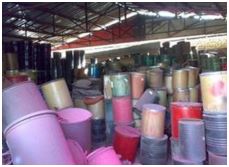Exploring the Rich Tradition of Indigo Dyeing in Indian Textile Production
Indigo Dyeing in India A Timeless Craft
Indigo dyeing is a centuries-old practice in India, renowned for producing vibrant blue hues that have captured the attention of fashion enthusiasts and textile connoisseurs around the globe. This ancient art form not only holds cultural significance but also reflects the rich heritage and craftsmanship that India is known for. The unique characteristics of indigo dye, its historical context, and its contemporary relevance make it a fascinating subject worth exploring.
Historical Context
Indigo dyeing in India traces its origins back to ancient civilizations. The dye is derived from the leaves of the Indigofera plant, which is indigenous to the Indian subcontinent. Historical records indicate that indigo was being cultivated and used for dyeing textiles as early as the Indus Valley civilization (around 2500 BC). The craft flourished during the Mughal era, where it was promoted as a luxury commodity across Europe and Asia. By the 19th century, Indian indigo became a sought-after dye, playing a pivotal role in trade and commerce, particularly under British colonial rule.
The process of indigo dyeing was labor-intensive and required a deep understanding of the plant’s properties. Artisans would carefully ferment the leaves to extract the dye, which would then be used on natural fibers to create stunning textiles. The use of indigo was not just a means of coloring fabric; it was part of rituals and traditions, symbolizing prosperity and protection.
The Craftsmanship of Indigo Dyeing
The process of indigo dyeing is a meticulous one that requires skill and patience. Traditional methods involve several steps, beginning with the harvesting of the indigo leaves. Once harvested, the leaves are fermented, which extracts the dye in the form of a blue liquid called “indigo vat.” The fabric, often cotton, is then immersed in this vat, absorbing the dye. A fascinating feature of indigo dyeing is that the fabric appears green when first dyed but gradually transforms into a deep blue as it oxidizes in the air.
Artisans employ various techniques to achieve different patterns and textures, including resist dyeing, tie-dyeing, and batik. Each technique has its own aesthetic and cultural significance. For example, the Bandhani (tie-dye) method employs intricate knots that resist dye penetration, resulting in stunning, often intricate patterns.
indigo dyeing in india products

Cultural Significance
Indigo dyeing is deeply woven into the fabric of Indian culture. Certain regions, such as Gujarat and Rajasthan, are particularly famous for their indigo textiles, which are often used in traditional attire, home furnishings, and artisanal crafts. The vibrant blue dye is not only aesthetically pleasing but also shares a rich symbolism within various communities. It is often associated with spirituality, protection against evil, and a sign of wealth.
In many rural communities, the art of indigo dyeing is passed down through generations, making it not just a trade but a way of life. This transmission of skills helps preserve local cultures and identity, allowing artisans to maintain their heritage in an ever-changing world.
Contemporary Relevance
Despite the advent of synthetic dyes, indigo dyeing continues to thrive in India. There is a growing demand for sustainable and eco-friendly products in the global market, and indigo, being a natural dye, aligns perfectly with this trend. Many contemporary designers are collaborating with local artisans to create innovative products that pay homage to traditional methods while catering to modern sensibilities.
Moreover, initiatives aimed at reviving traditional crafts are gaining momentum. Organizations focused on fair trade and sustainability are promoting indigo dyeing as a means of supporting local economies and empowering artisans. These efforts are essential for preserving this beautiful craft while adapting it to contemporary fashion trends.
Conclusion
Indigo dyeing in India is much more than just a method of coloring textiles; it is a rich tapestry of history, culture, and artistry. As we move towards a future that values sustainability and authenticity, the legacy of indigo dyeing continues to resonate. By embracing this traditional craft, we not only celebrate the beauty of Indian heritage but also support the artisans who keep this enchanting practice alive. The deep blue hues produced through indigo dyeing remind us of the beauty of craftsmanship that transcends time and boundaries, weaving together stories of tradition and innovation.
-
The Timeless Art of Denim Indigo Dye
NewsJul.01,2025
-
The Rise of Sulfur Dyed Denim
NewsJul.01,2025
-
The Rich Revival of the Best Indigo Dye
NewsJul.01,2025
-
The Enduring Strength of Sulphur Black
NewsJul.01,2025
-
The Ancient Art of Chinese Indigo Dye
NewsJul.01,2025
-
Industry Power of Indigo
NewsJul.01,2025
-
Black Sulfur is Leading the Next Wave
NewsJul.01,2025

Sulphur Black
1.Name: sulphur black; Sulfur Black; Sulphur Black 1;
2.Structure formula:
3.Molecule formula: C6H4N2O5
4.CAS No.: 1326-82-5
5.HS code: 32041911
6.Product specification:Appearance:black phosphorus flakes; black liquid

Bromo Indigo; Vat Bromo-Indigo; C.I.Vat Blue 5
1.Name: Bromo indigo; Vat bromo-indigo; C.I.Vat blue 5;
2.Structure formula:
3.Molecule formula: C16H6Br4N2O2
4.CAS No.: 2475-31-2
5.HS code: 3204151000 6.Major usage and instruction: Be mainly used to dye cotton fabrics.

Indigo Blue Vat Blue
1.Name: indigo blue,vat blue 1,
2.Structure formula:
3.Molecule formula: C16H10N2O2
4.. CAS No.: 482-89-3
5.Molecule weight: 262.62
6.HS code: 3204151000
7.Major usage and instruction: Be mainly used to dye cotton fabrics.

